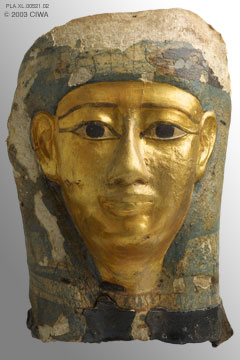Gilded mask, Thebes, 1100-1000 BC

Links to other views:⇒ Larger Viewif scripting is off, click the ⇒ instead. Links to others from High-Priests And Priest-Kings Of ThebesKa statue, High-Priest of Thebes PeriodOrnament of Satis, daughter of Hor, c. 980 BC Ornament of Satis, daughter of Hor, c. 980 BC Overseer shawabti of Amenemope, c. 1000 BC Overseer shawabti of Piankh, 1074-1070 BC Red clayware shawabti of Ankhefenmut Shawabti of Amenemope, c.1000 BC Shawabti of Djedkhonswiwfankh, 1000 BC Shawabti of General Amen, c. 1000 BC Shawabti of Hor, c. 1020-975 BC Shawabti of Nesitanebashru, 965 BC Shawabti of Nespaheran, c. 1000 BC Shawabti of Nespaiherhat, 1070-1030 BC Shawabti of Nespakanwty, 1000-950 BC Shawabti of Overseer Pahhmedat, 1000 BC Shawabti of Pennamen, c. 1000 BC Shawabti of Pinedjem II, 990-964 BC Shawabti of Queen Henuttawy, c.1050 BC Shawabti of Royal Scribe Idjedir, 1000 BC Links to others of type Coffin/sarcophagus of humansMummy mask of a young woman, Dyn. 18Wooden sarcophagus lid, 1800-1760 BC. Wooden sarcophagus lid, Dyn. 26 |
This exquisitely crafted cartonnage mask was most probably made for a Theban high dignitary, towards the end of Dynasty 20 or at the beginning of the period known as High-Priests and Priest-kings of Thebes, circa 1100-1000 BC. It once laid on the face of the mummy for which it was made. The high quality of craftsmanship is particularly evident in the embossing of difficult areas like the ears, in the smoothness of the gilding, and the precision of the painted decoration. Cartonnage Cartonnage was a material used in the production of personal funerary ornamentation (masks, pectorals, foot casings, and sometimes whole coffins). It was made with several layers of linen glued together and shaped in a mold. The resulting shell was usually coated on one side with gesso (a mixture of glue and whiting plaster). This smooth medium was well suited to detailed painting and gold leafing. Although earlier examples are known, it is around Dynasty 18 that cartonnage became a material of choice, and it remained a popular medium though the roman period. In later times, the linen layers were sometimes replaced with recycled papyrus documents. Many of the papyri currently studied by Egyptologists were recovered from cartonnage. Bibliography (on Cartonnage)Duke University,1991 Duke Papyrus Archive. http://scriptorium.lib.duke.edu/papyrus/, Durham, NC. Lucas, A., and J.R. Harris 1999 Ancient Egyptian Materials and Industries (unabridged republication of the 1962 fourth edition by Edward Arnold Publishers). Dover Publications, New York, NY. |